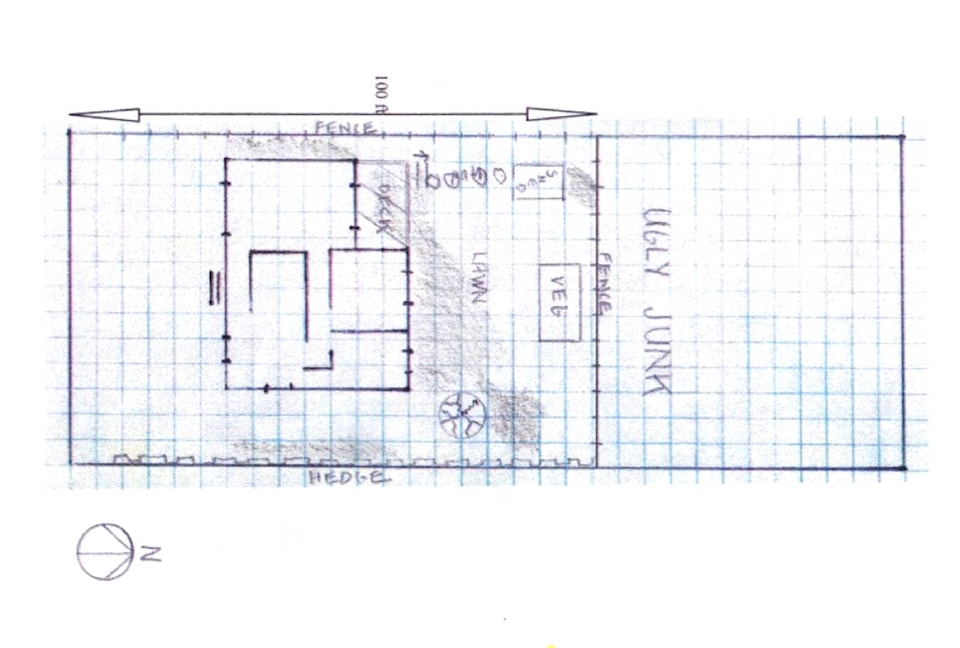By Jenny Wren
Plotting Existing Features
Now that you have your plot outline, you will need to add existing features. If you are planning a new garden with an empty canvas, you are almost ready! For those with an existing garden, you have a few more things to plot. Make sure you have copies of your original drawing. Take a copy of your original simple plot layout and mark on these things.
Aspect. Hopefully you have figured out the aspect of your house so now you will need to mark it on as shown in the diagram. If this house was facing south, the garden design would be very different so make sure this is correct. Many people fall in love with a house only to find when they move in they had not considered how sunlight will affect both interior light and the garden. There is a big contrast between heavily shaded areas and full direct sunlight.
Existing features. The simplest way to plot them is to use your fence or property line. Measure from a tree or the corner of a flower bed in the shortest straight line to the fence. Then from that point on the fence measure to the corner of the lot. Record those stride measurements on your rough drawing. Convert your strides into your chosen unit of measure, feet or meters. Use your scale to plot on the map. To be more accurate, triangulate and measure from the feature to the corner of the lot. Faintly draw your lines from lot corner to feature and feature to the fence line.
You will need to repeat this procedure for sheds, garages, raised beds and whatever else you have already existing in the garden and of course once you have the location marked you can measure the size of the features you are mapping. You don’t need to plot every shrub! Trees, planted areas and structures are enough, just major features. Guestimate the diameter of the tree canopy and draw a circle to rough scale.
Mark on existing paths and their width.
If you know where services enter your home, that can be a useful thing to mark. Just mark with an S and an arrow.
If you have a change in elevation through the garden, mark it with small arrows and the word ‘up’ in the right direction. We won’t get into surveying at this point. If you decide the rise or drop is great enough to require a retaining wall, that will be the job of the builder!
By now your first copy will be pretty full. You may wish to make a copy of this too. Once you have done all the measuring stuff, you don’t want to repeat it! Your finished drawing might look something like this.
Once again, it is a good idea to make a copy and or save on your computer. Just label them plan 1, plan 2 and so on as they change and you change ideas.
Now you have the planning information you need, you can start by figuring out which areas of your garden receive most shade. Lightly shade it in. Don’t forget to consider what your neighbours’ have going on in their gardens! If a large tree is on the east side of this garden it will add to the morning shade on the east side of this garden. With the back of this house facing north, it will be the front and back end of the garden that receive most sun. You can immediately see the sunniest area of the garden is along the back fence, where the vegetable bed is now. Beyond the fence it looks like there may be a view that needs changing!.
This is just the beginning of the fun part and you will go through several of your copies of the original drawings. After you have decided which features you do not wish to change or cannot change mark them in on the simpler plot plans sheets where you will be coming up with concept ideas. You don’t need to transfer anything else as you have the information you need on this full drawing and you can refer to it as you play with ideas.
We have a lot more things to consider as we plan so don’t get too carried away. There is a lot to think about now though. If you are interested in the previous articles in this series, you can find them on zonethreegardenlife.blog
